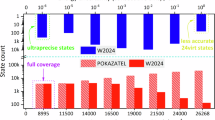Abstract
An account is given of our contributions to the SAMPL2 challenge for vacuum-water transfer energies. These contributions include different charge sets and radii used with Poisson–Boltzmann continuum theory applied to a single low-energy conformation. A rationale for this approach is given, including a summary of what we have learnt over previous SAMPL events. The results strongly suggest the need for new and repeated experimental measurements, both to clarify what appears to be experimental discrepancies in older measurements and to advance the field in a statistically sound manner.










Similar content being viewed by others
References
Nicholls A, Mobley DL, Guthrie JP, Chodera JD, Bayly CI, Cooper MD, Pande VS (2008) Predicting small-molecule solvation free energies: an informal blind test for computational chemistry. J Med Chem 51(4):769–779
Skillman AG, Nicholls A (2008) SAMPL2: statistical analysis of the modeling of proteins and ligands
Nicholls A, Wlodek S, Grant JA (2009) The SAMP1 solvation challenge: further lessons regarding the pitfalls of parametrization. J Phys Chem B 113(14):4521–4532
Jakalian A, Jack DB, Bayly CI (2002) Fast, efficient generation of high-quality atomic charges. AM1-BCC model: II. Parameterization and validation. J Comput Chem 23(16):1623–1641
Zhao Y, Truhlar DG (2006) A density functional that accounts for medium-range correlation energies in organic chemistry. Org Lett 8(25):5753–5755
Grant AJ, Pickup BT, Nicholls A (2001) A smooth permittivity function for Poisson–Boltzmann solvation methods. J Comp Chem 22:608–640
Gilson M, Rashin A, Fine R, Honig B (1985) On the calculation of electrostatic interactions in proteins. J Mol Biol 184:503–516
Nicholls A, Honig B (1991) A rapid finite difference algorithm, utilizing successive over-relaxation to solve the Poisson–Boltzmann equation. J Comp Chem 12(4):435–445
OMEGA http://www.eyesopen.com/products/applications/omega.html
SZYBKI http://www.eyesopen.com/products/applications/szybki.html
Hertwig RH, Koch W (1997) On the parameterization of the local correlation functional. What is Becke-3-LYP? Chem Phys Lett 268(5–6):345–351
Gaussian I. www.gaussian.com
Singh UC, Kollman PA (1994) An approach to computing electrostatic charges for molecules. J Comp Chem 5(2):129–145
QUACPAC http://www.eyesopen.com/products/applications/quacpac.html
Ellingson BA, Skillman AG, Nicholls A (2010) Analysis of SM8 and Zap TK calculations and their geometric sensitivity. JCAMD 24. doi:10.1007/s10822-010-9355-3
Bondi A (1964) J Phys Chem 64:441
Kelly CP, Cramer CJ, Truhlar DG (2005) SM6: a density functional theory continuum solvation model for calculating aqueous solvation free energies of neutrals, ions, and solute-water clusters. J Chem Theory Comput 1:1133–1152
Sharp KA, Nicholls A, Fine RF, Honig B (1991) Reconciling the magnitude of the microscopic and macroscopic hydrophobic effects. Science 252(5002):106–109
Jones FM, Arnett EM (1974) Prog Phys Org Chem 11:263–322
Ben-Naim A, Marcus Y (1984) J Chem Phys 81:2016–2027
Marten B, Kim K, Cortis C, Friesner RA, Murphy RB, Ringnalda MN, Sitkoff D, Honig B (1996) J Phys Chem 100:11775–11788
Rizzo RC, Jorgensen WL (1999) OPLS all-atom model for amines: resolution of the amine hydration problem. JACS 121:4827–4836
McClellan AL (1963) Tables of experimental dipole moments, 1st edn. W. H. Freeman and Co., New York
Mobley DL, Dill KA, Chodera JD (2008) Treating entropy and conformational changes in implicit solvent simulations of small molecules. J Phys Chem B 112(3):938–946
Rashin AA, Honig B (1985) Reevaluation of the Born model of ion hydration. J Phys Chem 89(26):5588–5593
Geballe M, Skillman AG, Nicholls A, Guthrie JP, Taylor PJ (2010) The SAMPL2 blind prediction challenge: introduction and overview. JCAMD 24. doi:10.1007/s10822-010-9350-8
Ren P, Ponder JW (2003) Polarizable atomic multipole water model for molecular mechanics simulation. J Phys Chem B 107:5933–5947
Lide DR (ed) (1998) CRC handbook of chemistry and physics, 79th edn. CRC Press, Boco Raton
Gallicchio E, Zhang LY, Levy RM (2002) The SGB/NP hydration free energy model based on the surface generalized born solvent reaction field and novel nonpolar hydration free energy estimators. J Comput Chem 23(5):517–529
Sitkoff D, Sharp K, Honig B (1994) Accurate calculation of hydration free energies using macroscopic solvent models. J Phys Chem 98:1978–1988
Bordner AJ, Cavasotto CN, Abagyan RA (2002) Accurate transferable model for water, n-Octanol and n-Hexadecane solvation free energies. J Phys Chem B 106:11009–11015
Author information
Authors and Affiliations
Corresponding author
Electronic supplementary material
Below is the link to the electronic supplementary material.
Rights and permissions
About this article
Cite this article
Nicholls, A., Wlodek, S. & Grant, J.A. SAMPL2 and continuum modeling. J Comput Aided Mol Des 24, 293–306 (2010). https://doi.org/10.1007/s10822-010-9334-8
Received:
Accepted:
Published:
Issue Date:
DOI: https://doi.org/10.1007/s10822-010-9334-8




